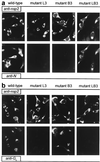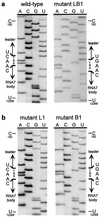Arterivirus discontinuous mRNA transcription is guided by base pairing between sense and antisense transcription-regulating sequences
- PMID: 10518575
- PMCID: PMC18411
- DOI: 10.1073/pnas.96.21.12056
Arterivirus discontinuous mRNA transcription is guided by base pairing between sense and antisense transcription-regulating sequences
Abstract
To generate an extensive set of subgenomic (sg) mRNAs, nidoviruses (arteriviruses and coronaviruses) use a mechanism of discontinuous transcription. During this process, mRNAs are generated that represent the genomic 5' sequence, the so-called leader RNA, fused at specific positions to different 3' regions of the genome. The fusion of the leader to the mRNA bodies occurs at a short, conserved sequence element, the transcription-regulating sequence (TRS), which precedes every transcription unit in the genome and is also present at the 3' end of the leader sequence. Here, we have used site-directed mutagenesis of the infectious cDNA clone of the arterivirus equine arteritis virus to show that sg mRNA synthesis requires a base-pairing interaction between the leader TRS and the complement of a body TRS in the viral negative strand. Mutagenesis of the body TRS of equine arteritis virus RNA7 reduced sg RNA7 transcription severely or abolished it completely. Mutations in the leader TRS dramatically influenced the synthesis of all sg mRNAs. The construction of double mutants in which a mutant leader TRS was combined with the corresponding mutant RNA7 body TRS resulted in the specific restoration of mRNA7 synthesis. The analysis of the mRNA leader-body junctions of a number of mutants with partial transcriptional activity provided support for a mechanism of discontinuous minus-strand transcription that resembles similarity-assisted, copy-choice RNA recombination.
Figures






Similar articles
-
The stability of the duplex between sense and antisense transcription-regulating sequences is a crucial factor in arterivirus subgenomic mRNA synthesis.J Virol. 2003 Jan;77(2):1175-83. doi: 10.1128/jvi.77.2.1175-1183.2003. J Virol. 2003. PMID: 12502834 Free PMC article.
-
Discontinuous subgenomic RNA synthesis in arteriviruses is guided by an RNA hairpin structure located in the genomic leader region.J Virol. 2005 May;79(10):6312-24. doi: 10.1128/JVI.79.10.6312-6324.2005. J Virol. 2005. PMID: 15858015 Free PMC article.
-
Genetic manipulation of arterivirus alternative mRNA leader-body junction sites reveals tight regulation of structural protein expression.J Virol. 2000 Dec;74(24):11642-53. doi: 10.1128/jvi.74.24.11642-11653.2000. J Virol. 2000. PMID: 11090163 Free PMC article.
-
Nidovirus transcription: how to make sense...?J Gen Virol. 2006 Jun;87(Pt 6):1403-1421. doi: 10.1099/vir.0.81611-0. J Gen Virol. 2006. PMID: 16690906 Review.
-
A new model for coronavirus transcription.Adv Exp Med Biol. 1998;440:215-9. doi: 10.1007/978-1-4615-5331-1_26. Adv Exp Med Biol. 1998. PMID: 9782283 Review.
Cited by
-
Two cellular proteins that interact with a stem loop in the simian hemorrhagic fever virus 3'(+)NCR RNA.Virus Res. 2005 May;109(2):109-24. doi: 10.1016/j.virusres.2004.11.014. Epub 2004 Dec 18. Virus Res. 2005. PMID: 15763141 Free PMC article.
-
Secondary structure and function of the 5'-proximal region of the equine arteritis virus RNA genome.RNA. 2004 Mar;10(3):424-37. doi: 10.1261/rna.5174804. RNA. 2004. PMID: 14970388 Free PMC article.
-
The PRRSV replicase: exploring the multifunctionality of an intriguing set of nonstructural proteins.Virus Res. 2010 Dec;154(1-2):61-76. doi: 10.1016/j.virusres.2010.07.030. Epub 2010 Aug 7. Virus Res. 2010. PMID: 20696193 Free PMC article. Review.
-
Torovirus non-discontinuous transcription: mutational analysis of a subgenomic mRNA promoter.J Virol. 2005 Jul;79(13):8275-81. doi: 10.1128/JVI.79.13.8275-8281.2005. J Virol. 2005. PMID: 15956573 Free PMC article.
-
A second functional RNA domain in the 5' UTR of the Tomato bushy stunt virus genome: intra- and interdomain interactions mediate viral RNA replication.RNA. 2003 Oct;9(10):1232-45. doi: 10.1261/rna.5630203. RNA. 2003. PMID: 13130137 Free PMC article.
References
-
- McKnight S L, Yamamoto K R. Transcriptional Regulation. Plainview, NY: Cold Spring Harbor Lab. Press; 1992.
-
- von Hippel P H. Science. 1998;281:660–665. - PubMed
Publication types
MeSH terms
Substances
Associated data
- Actions
LinkOut - more resources
Full Text Sources
Other Literature Sources

